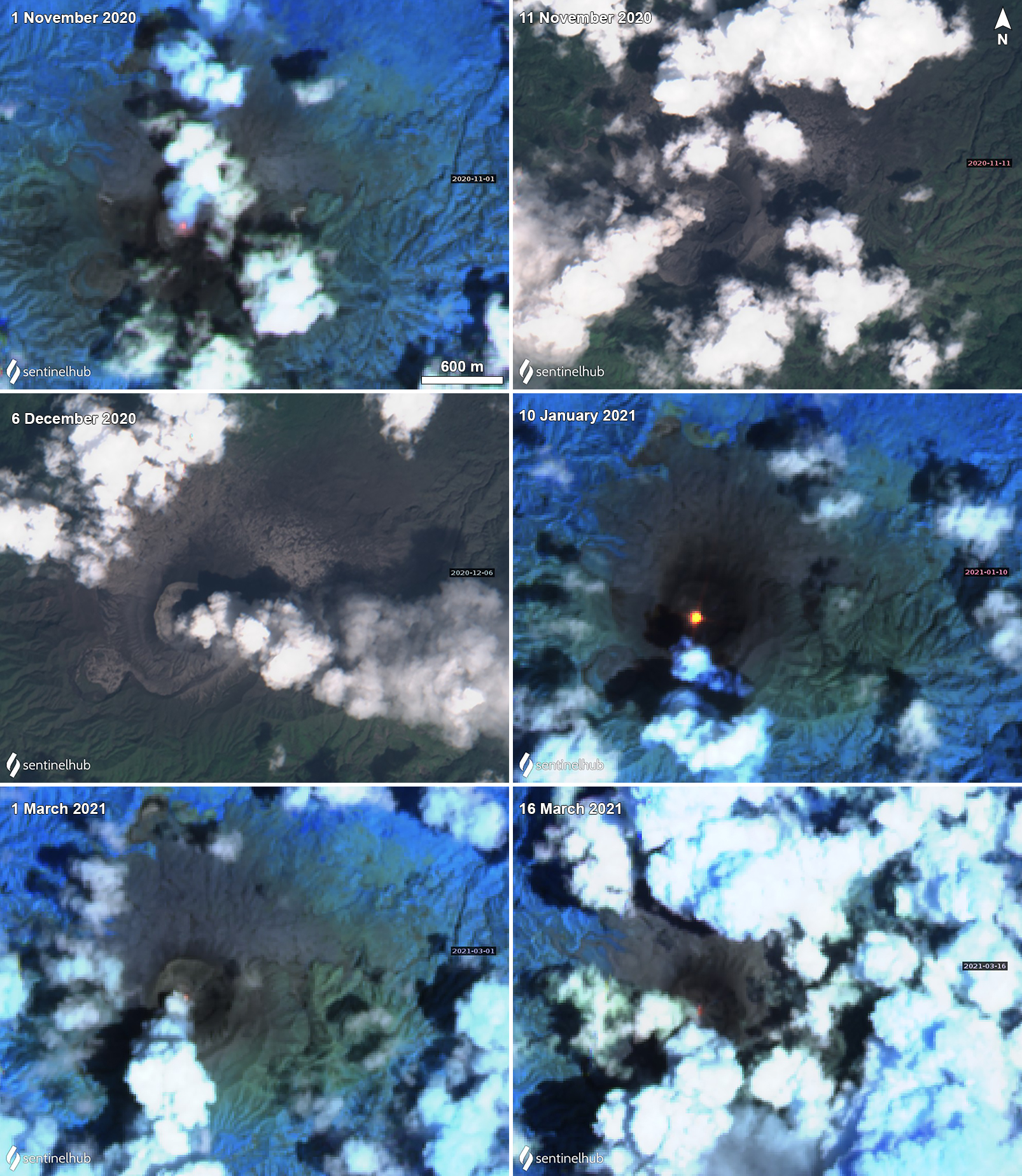Report on Dukono (Indonesia) — April 2021
Bulletin of the Global Volcanism Network, vol. 46, no. 4 (April 2021)
Managing Editor: Edward Venzke.
Edited by Kadie L. Bennis.
Dukono (Indonesia) Ash and sulfur dioxide plumes during October 2020-March 2021
Please cite this report as:
Global Volcanism Program, 2021. Report on Dukono (Indonesia) (Bennis, K.L., and Venzke, E., eds.). Bulletin of the Global Volcanism Network, 46:4. Smithsonian Institution. https://doi.org/10.5479/si.GVP.BGVN202104-268010
Dukono
Indonesia
1.6992°N, 127.8783°E; summit elev. 1273 m
All times are local (unless otherwise noted)
Dukono, located in northernmost Halmahera, Indonesia, has been erupting continuously since 1933. Volcanism has recently been characterized by frequent ash explosions, ash plumes, and sulfur dioxide plumes (BGVN 45:10). This report updates activity consisting of white-and-gray plumes and sulfur dioxide plumes during October 2020-March 2021 using information primarily from the Pusat Vulkanologi dan Mitigasi Bencana Geologi (PVMBG, also known as Indonesian Center for Volcanology and Geological Hazard Mitigation, CVGHM), the Darwin Volcanic Ash Advisory Centre (VAAC), and satellite data.
Volcanism at Dukono has been characterized by dominantly white-and-gray plumes, accompanied by intermittent ash plumes that drifted in multiple directions. On clear weather days, the ash plumes rose to 1.5-2.4 km altitude, or about 270-1,200 m above the crater, according to PVMBG and the Darwin VAAC advisories (table 23).
Table 23. Monthly summary of reported ash plumes from Dukono during October 2020-March 2021. The direction of drift for the ash plumes was highly variable; notable plume drifts each month were only indicated in the table if at least two weekly reports were consistent. Data courtesy of PVMBG and the Darwin VAAC.
| Month | Plume altitude (km) | Notable plume drift |
| Oct 2020 | 1.8-2.4 | W, N, NE, E, SW |
| Nov 2020 | 1.5-2.1 | Multiple directions |
| Dec 2020 | 1.5-2.4 | SE, E |
| Jan 2021 | 1.5-2.1 | SW, E |
| Feb 2021 | 1.5-2.1 | Multiple directions |
| Mar 2021 | 1.5-2.4 | Multiple directions |
Activity during October 2020 primarily consisted of near daily white-and-gray plumes that rose 100-700 m above the crater and drifted in multiple directions (figure 19). Ash plumes during this month rose between 1.8 and 2.4 km altitude and drifted W, N, NE, E, SW, according to PVMBG VONA notices and the Darwin VAAC advisories. Frequent white gas-and-steam emissions were also observed in webcam images. Similar activity continued in November, with almost daily white-and-gray plumes rising 100-800 m above the crater and drifting in multiple directions. On clear weather days ash plumes were observed up to 2.1 km altitude; on 12 November the ash plume rose up to 2.1 km altitude and drifted SW (figure 19).
 |
Figure 19. Webcam images of white-and-gray plumes rising from Dukono on 8 October (left) and an ash plume on 12 November (right) 2020. Courtesy of MAGMA Indonesia. |
In December and January 2021, white-and-gray plumes were 100-700 m above the crater and drifted in multiple directions, dominantly E and W in December and SW in January. According to Darwin VAAC advisories during these two months, ash plumes were seen rising to 2.4 km altitude and drifted notably SE, E, and SW.
Activity in February persisted with white-and gray plumes rising 100-600 m above the crater and drifting dominantly SW and E (figure 20). Intermittent ash plumes rose to 2.1 km altitude during February and 2.4 km altitude during March, drifting in multiple directions. Gas-and-steam plumes were also frequent. During March, almost daily white-and-gray plumes rose 100-800 m above the crater and drifted in multiple directions (figure 20).
 |
Figure 20. Webcam images of white-and-gray plumes rising from Dukono on 25 February (left) and 22 March (right) 2021. Courtesy of MAGMA Indonesia. |
The NASA Global Sulfur Dioxide page, using data from the TROPOMI instrument on the Sentinel-5P satellite, showed strong SO2 plumes rising from Dukono and drifting in various directions (figure 21). In addition to SO2 plumes, Sentinel-2 thermal satellite imagery showed thermal anomalies of variable intensities on clear weather days (figure 22). Intermittent thermal anomalies recorded by the MIROVA (Middle InfraRed Observation of Volcanic Activity) system during early December 2020 through mid-March 2021 were low in power (figure 23). A brief break in thermal activity occurred during mid- to late-February.
Geological Summary. Reports from this remote volcano in northernmost Halmahera are rare, but Dukono has been one of Indonesia's most active volcanoes. More-or-less continuous explosive eruptions, sometimes accompanied by lava flows, have occurred since 1933. During a major eruption in 1550 CE, a lava flow filled in the strait between Halmahera and the N-flank Gunung Mamuya cone. This complex volcano presents a broad, low profile with multiple summit peaks and overlapping craters. Malupang Wariang, 1 km SW of the summit crater complex, contains a 700 x 570 m crater that has also been active during historical time.
Information Contacts: Pusat Vulkanologi dan Mitigasi Bencana Geologi (PVMBG, also known as Indonesian Center for Volcanology and Geological Hazard Mitigation, CVGHM), Jalan Diponegoro 57, Bandung 40122, Indonesia (URL: http://www.vsi.esdm.go.id/); MAGMA Indonesia, Kementerian Energi dan Sumber Daya Mineral (URL: https://magma.esdm.go.id/v1); Darwin Volcanic Ash Advisory Centre (VAAC), Bureau of Meteorology, Northern Territory Regional Office, PO Box 40050, Casuarina, NT 0811, Australia (URL: http://www.bom.gov.au/info/vaac/); NASA Global Sulfur Dioxide Monitoring Page, Atmospheric Chemistry and Dynamics Laboratory, NASA Goddard Space Flight Center (NASA/GSFC), 8800 Greenbelt Road, Goddard, Maryland, USA (URL: https://so2.gsfc.nasa.gov/); Sentinel Hub Playground (URL: https://www.sentinel-hub.com/explore/sentinel-playground).




